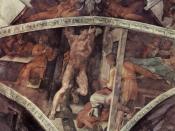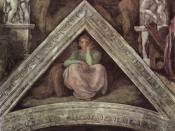The Sistine Chapel Ceiling The Sistine Chapel ceiling is perhaps the most amazing painting of all time. It was finished by Michealangelo Buonarroti in 1512.(he started it in 1508.) He worked on the painting every day in the four year period. It was grueling work. He would have to climb a scaffolding and lay flat on his back 65 feet above the floor with paint dripping down on him. All of the scenes were based on stories of The Bible. The centerpiece, "The Creation Of Adam" shows God infusing life into Adam, the first man. The triangular areas along the two long sides of the ceiling are called spandrels. The moldings which outline them are the only aspects of the architectural design of the Ceiling that are truly part of the architecture. The moldings were in the ceiling before Michelangelo began his project. All other architectural details on the Ceiling were painted by Michelangelo.
The figures painted inside the spandrels represent ancestors of Christ. (These figures are also continued into the lunettes below the Ceiling.) The prophets and sibyls could be seen as mediating between the Old and New Testaments in a spiritual or prophetic way. The ancestors mediate between the two in a concrete or biological way. Michelangelo was first assigned to paint the ceiling when he received a letter from the Pope. This letter reveals that the idea of completing the Chapel begun by Sixtus IV had been broached while Michelangelo was previously in Rome. Michelangelo told him that the didn't want to paint the Chapel doubting he had the ability to paint foreshortened figures. On May 10, 1508 Michelangelo contracted to paint the ceiling for 3,000 ducats1 and began work that very day. The ceiling is divided into three zones, the highest showing scenes from Genesis. Below...


